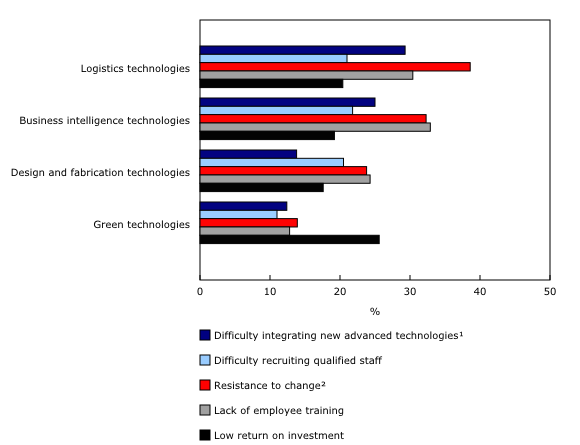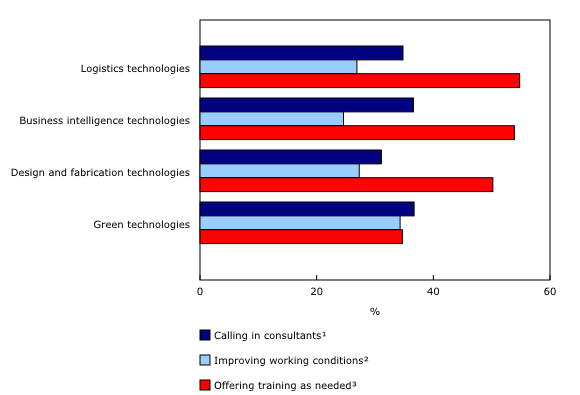Survey of Advanced Technology: Objectives, obstacles and measures taken to reduce obstacles, 2014
Archived Content
Information identified as archived is provided for reference, research or recordkeeping purposes. It is not subject to the Government of Canada Web Standards and has not been altered or updated since it was archived. Please "contact us" to request a format other than those available.
Released: 2015-12-11
Lowering operating costs was the primary objective of most enterprises that adopted advanced technology.
Mismatches between the skills needed by enterprises and employee training, as well as employees' resistance to change were the most common obstacles faced by enterprises that adopted an advanced technology.
Enterprises most frequently mitigated the obstacles to adopting advanced technology by offering advanced training, and hiring consultants or subcontracting for short-term needs.
Enterprises that adopted advanced technology do so with an expectation of meeting certain objectives. Knowing what these objectives were and the extent to which they were achieved provides insight into which technologies are more attractive. Similarly, being aware of the obstacles enterprises faced and the measures taken to mitigate those obstacles are key to understanding the adoption process of advanced technologies by Canadian enterprises.
Why do enterprises adopt advanced technology?
Enterprises reported lowering operating costs as their primary objective for adopting technology from three of the four advanced technology groups in the survey. This reason was cited by 68.1% of enterprises that adopted an advanced business intelligence technology, by 64.2% of enterprises that adopted an advanced logistics technology, and by 59.9% of enterprises that adopted an advanced design and fabrication technology.
The extent to which enterprises achieved their objective of lowering operating costs ranged from 59.4% of those that adopted an advanced design and fabrication technology to 69.3% of those that adopted an advanced logistics technology.
In contrast, 82.2% of enterprises that adopted an advanced green technology reported that their primary objective was to lower their environmental impact. This objective was met or exceeded by nearly 9 in 10 enterprises.
Skills mismatch is the largest obstacle faced by enterprises that adopt advanced technology
Of 12 obstacles identified, 5 were consistently reported by all enterprises and across all four advanced technology groups. Three of these obstacles related directly to the mismatch between employee training and the skills required to operate advanced technology. The remaining obstacles related to the ability to integrate the new technology with existing systems, and a low return on investment.
Enterprises that adopted advanced logistics technologies reportedly experienced employee resistance to change more than enterprises that adopted technologies from the other groups. The forestry and logging, and utilities sectors faced this obstacle the most. In particular, almost half of forestry and logging enterprises (46.8%) experienced employee resistance to change, while nearly as many enterprises in the utilities sector (45.4%) also reported this obstacle.
Training the key measure taken to reduce obstacles to adopting advanced technology
Enterprises were also asked to identify the measures taken to reduce obstacles to adopting advanced technology.
Of 12 specified measures taken to reduce obstacles, 3 were reported most frequently regardless of the advanced technology group from which the technology was adopted. All 3 related to improving the enterprise's human capital: namely, calling in consultants for short-term needs, improving working conditions (flexible hours, health and safety, etc.), and offering training as needed.
Note to readers
The Survey of Advanced Technology is an occasional survey that collects essential information on the extent to which Canadian enterprises use advanced technologies. Just under 12,000 enterprises were surveyed from a population of 85,000 enterprises in 87 industry groupings. The sample was stratified by enterprise employment size.
An advanced technology is one that performs a new function or significantly improves an existing function performed by a more commonly used technology. For the purposes of this survey, 41 advanced technologies were selected and divided into four technology groups:
- Advanced logistics (advanced material handling, supply chain and logistics),
- Advanced business intelligence,
- Advanced design and fabrication (advanced design, information control, processing and fabrication),
- Advanced green technology.
For more information, please see the Daily release entitled "Survey of Advanced Technology," released today.
Contact information
For more information, or to enquire about the concepts, methods or data quality of this release, contact us (toll-free 1-800-263-1136; 514-283-8300; STATCAN.infostats-infostats.STATCAN@canada.ca) or Media Relations (613-951-4636; STATCAN.mediahotline-ligneinfomedias.STATCAN@canada.ca).
- Date modified:



